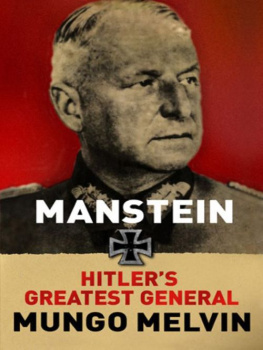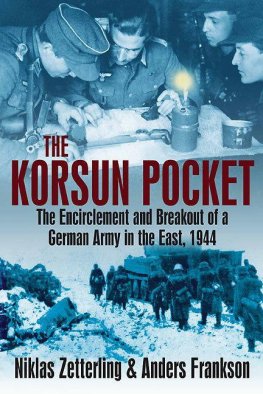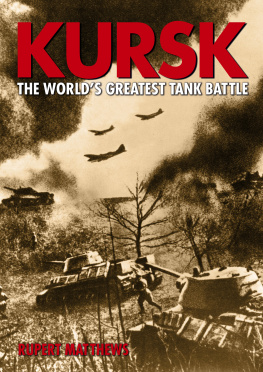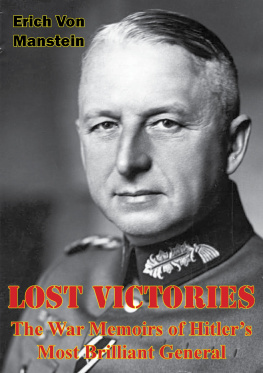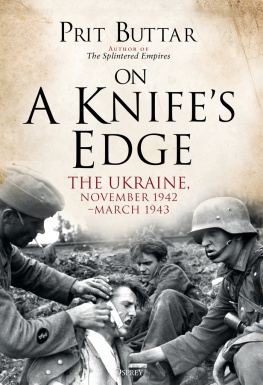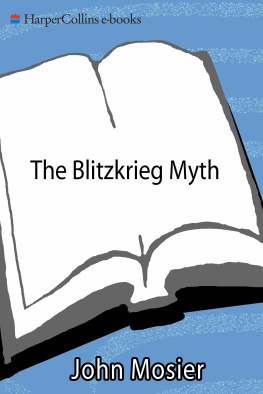Table of Contents
Manstein
MUNGO MELVIN
Orion
www.orionbooks.co.uk
An Orion ebook
First published in Great Britain in 2010 by Orion Books
This ebook first published in 2010 by Orion Books
Mungo Melvin, 2010
The right of Mungo Melvin to be identified as the author of this work has been asserted in accordance with the
Copyright, Designs and Patents Act 1988.
All rights reserved. No part of this publication may be reproduced, stored in a
retrieval system, or transmitted in any form or by any means, without the prior
permission in writing of the publisher, nor to be otherwise circulated in any form of
binding or cover than that in which it is published without a similar condition,
including this condition, being imposed on the subsequent publisher.
A CIP catalogue record for this book
is available from the British Library.
eISBN : 978 0 2978 5844 7
This ebook produced by Jouve, France
Orion Books
An imprint of the Orion Publishing Group Ltd
Orion House
5 Upper Saint Martins Lane
London WC2H 9EA
An Hachette UK Company
www.orionbooks.co.uk
Authors Note on Spellings and Military Terminology
In writing this book, I have attempted to follow the many conventions of formulation and style common in both general and military writing, but have risked diverging from them when it seemed sensible to do so. In Central and East European place names, for example, I have used historical German and Russian titles rather than the modern Ukrainian, and apologize to my Ukrainian friends for doing so. Hence I refer to Lemberg (German) or Lvov (Russian) but not Lviv (Ukrainian). Within Russian, I have dropped the soft sign Russian b normally rendered in English as an apostrophe. So I use Sevastopol, not Sevastopol, and Kharkov, rather than either Kharkov (Russian) or Kharkiv (Ukrainian). For consistency, not least to provide commonality with David Glantzs scholarship, I use the Russian Dnepr rather than the Ukrainian Dnipro or German Dnieper for that great river; similarly, Dnestr rather than either Dnister (Ukrainian) or Dneister (German).
In the nomenclature of large formations, from the German I translate Heeresgruppe as army group, but retain Front for a Soviet group of armies. I use Eleventh when referring to a German army and 64th, for example, when describing a Soviet one. I retain the Roman number of a German corps (such as Mansteins LVI), but use an Arabic one for an equivalent Soviet formation. I use the specific term Panzer for a German armoured unit and Tank for a Soviet one. These distinctions may appear a trifle pedantic, but they make a complex battle narrative between German and Soviet forces easier to follow. For a general description of the symbols used in the maps, see the general key below Map 1. Where more explanation is required, see the specific keys on the following maps.
Prologue
I pay tribute before the whole German people to the heroic achievements of the troops fighting under your command.
Adolf Hitler
After four weeks of hard pounding, the guns fell silent on 1 July 1942 over the once mighty citadel and naval base of Sevastopol. As the clouds of dust and acrid smoke lifted, an eerie stillness descended over the battered town and port. Although some isolated pockets of the Red Army continued to resist fanatically for a few days more, the last major Soviet bastion on the Crimea had fallen to the invading German and Rumanian forces. For over eight months the veteran troops of Colonel General Erich von Mansteins Eleventh Army had invested the seemingly impregnable fortress, purportedly the strongest in the world, whose capture had become for Hitler as much a matter of political prestige as a military object. The great siege had ended with a spectacular feat of German arms, one last great - gasping - triumph for Germany during the Second World War before the crushing debacle at Stalingrad, six months later.
The ferocious struggle for Sevastopol remains - in the West at least - a dimly recalled event, a dark and distant chapter in the German-Soviet conflict so large in scale and desperate in nature that it continues to defy modern imagination. Manstein, the victor, is almost as forgotten as the campaign of nearly seventy years ago. The final attack of June 1942, with all the heavy artillery and close air support that the Wehrmacht could put at his disposal, only just succeeded. Losses on both sides had been horrendous. And for the Germans, the bloody battles for the city would prove a dramatic episode in an ultimately unsuccessful war. Of the victory hard won in July 1942, by May 1944 all had been lost and the Crimea abandoned. On 1 May 1945, Stalin announced that brave Sevastopol, along with Leningrad, Moscow and Stalingrad, was to become a herocity of the Soviet Union.
The summer of 1942 marked the high-water mark in Germanys fortunes in the Second World War. In the Western Desert, Colonel General Erwin Rommel had captured the stronghold of Tobruk on 21 June, and the British Eighth Army was in headlong retreat towards Egypt and the Nile. For the Allies, the prospects looked equally grim in the Soviet Union. In recent months on the Eastern Front, Soviet armies near Leningrad, Kharkov in the Ukraine and on the Kerch peninsula on the Crimea had all been defeated decisively. As Manstein savoured his crowning success at Sevastopol, the main weight of the German Army in the East - under the aegis of Operation BLUE - was beginning its overly ambitious summer offensive towards the Caucasus and its economically crucial oilfields that would lead to the fatal distraction and climactic battle of Stalingrad. Despite incurring over a million casualties since the start of Operation BARBAROSSA on 22 June 1941, Hitlers hopes of smashing Bolshevism in the summer of 1942 were still high, if not unduly optimistic.
In the meantime, Germany could celebrate another splendid victory. It earned Erich von Manstein, at the age of 54, his field marshals baton: the zenith of his career. Preceded by a triumphant fanfare, Berlin radio broadcast a special communiqu announcing the fall of Sevastopol. Shortly after, Hitlers warm congratulatory message clattered over the teleprinter link to the Eleventh Armys forward command post at the Tatar settlement of Yukhary Karales, now called Zalesnoe, 20 kilometres due east of Sevastopol:
To the Commander-in-Chief of the Crimean Army,
Colonel-General v. Manstein,
In grateful appreciation of your exceptionally meritorious services in the victorious battles of the Crimea, culminating in the annihilation of the enemy at Kerch and the conquest of the mighty fortress of Sevastopol, I hereby promote you Field-Marshal. By your promotion and the creation of a commemorative shield to be worn by all ranks who took part in the Crimean campaign, I pay tribute before the whole German people to the heroic achievements of the troops fighting under your command.
ADOLF HITLER
The largely self-contained campaign on the Crimea in 1941-42 had proved a bitter and costly fight, in many senses a microcosm of the much wider, total war waging between Germany and the Soviet Union that stretched from the Barents Sea in the Arctic north to the Black Sea in the south. Whilst German personnel and matriel losses continued to mount, the capability of the Red Army was on the increase - quantitatively if not yet qualitatively - despite the grievous damage it had suffered thus far in fighting a sacred war (sviashchennaya voyna) in defence of Mother Russia.
In stark contrast with the First World War, when most of Germanys military effort was directed and expended on the Western Front, from June 1941 onwards the

